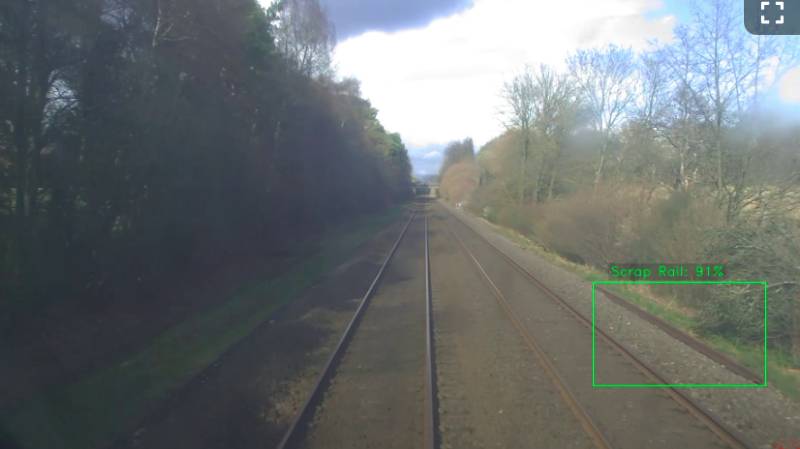RailStaff takes a look at the use of AI in rail and considers its wider implications for the industry.
You’ll hardly have missed the fact that Artificial Intelligence (AI) has been headline news for some time. The technology which once seemed a dream (or nightmare) is developing at a pace, and regulators are racing to catch up. For years, AI seemed just beyond the horizon, but it’s no longer a buzzword in tech circles. It’s a game-changer that will revolutionize operations, enhance safety, and improve customer experiences. Here we examine it’s uses and potential pitfalls.
Maintenance and monitoring
AI-powered predictive maintenance is currently helping to prevent breakdowns and costly delays by analysing vast amounts of data from sensors and cameras across the rail network. By identifying patterns and anomalies, AI algorithms can predict when maintenance is needed, allowing Network Rail, the UK’s infrastructure owner, to proactively address potential issues before they escalate.
It is also playing a crucial role in monitoring the condition of railway tracks and structures. Image recognition software can analyse high-resolution footage to detect defects, wear and tear, and potential hazards. This data can then be fed into AI models to assess the severity of the issues and recommend corrective actions.
In July this year, Network Rail announced it was trialling AI and video technology on the Wessex Route, to make the railway safer, cleaner and greener. AI and Automated Intelligent Video Review (AIVR), a system developed by tech company One Big Circle, was employed to help find and remove forgotten scrap left on the side of the railway.
AIVR is a phone-sized device mounted to the front of the train which takes high-definition footage from across the network. This footage is then analysed by AI which looks for scrap rail, sleepers, and bags of ballast, and maps their locations using the global positioning system (GPS).
The technology makes it much easier for maintenance teams to plan how and when to safely remove the items and either re-use or recycle them.


Wayne Cherry, senior innovations engineer at Network Rail, explained: “While AIVR is already in use across other parts of Network Rail, this will be the first time this technology has been used in this way with AI and could be a real game-changer.
“Not only is scrap on the side of the railway unsightly, but it can also become an obstacle during planned engineering work, block safe walkways or delay our teams accessing part of the railway infrastructure to make repairs during disruption.”
Martyn Shaftoe, workforce health, safety and environment adviser for the Wessex route and the lead for this project, added: “Unfortunately, over recent years, the railway has become somewhat of a dumping ground for discarded railway sleepers, scrap rail, redundant ballast bags and many other assets. The challenge we face is there is no definitive list of where these materials or assets are.
“This new technology allows us now to accurately locate scrap material without the need for anyone to walk along the railway, helping keep our staff safe. Martyn called it “a huge safety improvement opportunity.
“To be able to help the industry potentially save money by reusing or recycling this treasure-trove of scrap materials is a brilliant prospect and we look forward to hopefully rolling it out more widely across the business.”
Safety
A further use of AI is in reducing risk for staff and passengers across the network. AI is in use to analyse real-time data and detect and respond to potential hazards. For instance, AI can monitor train movements and identify anomalies, such as sudden braking or derailments, prompting immediate action to ensure the safety of passengers and crew.
As an example, the Rail Safety and Standards Board (RSSB) announced in January 2023 that it was collaborating with the University of Sheffield to develop a tool using AI to predict low adhesion conditions.

With low adhesion costing the rail sector around £350 million each year and being a causative factor of accidents such as at Salisbury in 2021, it has been the subject of much research in recent years. The RSSB/University of Sheffield initiative explored how a deeper understanding of local conditions can be used to tackle the challenge of ‘leaves on the line’.
Wheel and rail adhesion is substantially affected by conditions including temperature, humidity, and the presence of contaminants such as oil and grease, or leaf layers. The RSSB’s goal is to “combine local data, including high-resolution video, to deliver more accurate predictions about friction at the wheel-rail interface, and potentially longer-range predictions.”
Greater knowledge of local conditions could be used to plan more efficient and effective railhead cleaning schedules, or used by route controllers to support operational decision making. The information gathered could also be used to deliver insights into train braking and performance models.
In the same vein, Danish firm PantoInspect has developed an automated, real-time pantograph monitoring device to record sensor data and images of overhead wires. The fully automated system uses a combination of AI, algorithms, and 3D laser triangulation to offer accurate and reliable detection of damaged pantographs.
The system operates 24 hours a day, regardless of the weather conditions, producing live images and 3D scans for trains running up to 350 kmph. Operators are instantly notified when a damaged pantograph is detected and trains are automatically inspected with no impact on daily operation.
Customer experience
Passenger information and communication is another beneficiary of AI technology. Chatbots are now able to handle customer inquiries, provide real-time train updates, and assist with ticket purchases and travel arrangements. This means passengers can receive timely and accurate information about their journeys, and staff are freed up to focus on more complex tasks.
In October, train operator Northern announced it had partnered with software development firm Audacia to launch a new AI-powered chatbot on WhatsApp. The chatbot uses natural language processing to provide Northern’s customers with quick access to live train times, delays, cancellations, and more to improve the passenger experience.

The chatbot was built using Microsoft software which enabled advanced conversational capabilities and it can understand context and respond accurately to customer queries in real-time. Over 22,000 sound clips were used to train the machine learning model which powers it.
AI is also simplifying ticketing and fare collection processes, making it more convenient for passengers to purchase and validate their tickets. AI-powered self-service kiosks and mobile apps can handle ticket purchases, fare calculations, and contactless payments, speeding up the boarding process and reducing queues.
Challenges and shortcomings
But herein lies one of the problems of AI, and just one of the reasons that regulation and clearer thinking is needed. When automating roles that humans have traditionally filled, the spectre of job cuts raises its head. It was only in late-October that a Department of Transport (DfT) plan to close hundreds of ticket offices across the country was scrapped.
Although the proposals, which would have made great use of AI-powered solutions, were made by the train operators managing the station offices, they were widely understood to have been driven by a government eager to cut costs.
The DfT’s back-tracking resulted from a huge public backlash, which saw 750,000 responses in a public consultation, 99% of which were objections, according to passenger watchdogs.
Concerns over accessibility were a key driver of the climbdown, with campaigners for disabled people calling the plans “absurd”.
Disable peopled “take a lot of comfort and reassurance from knowing that there is a ticket office and that is where they can go to ask questions, to get help when inevitably things go wrong on their journey,” said Louise Rubin, the head of policy and campaigns at Scope, when she spoke at the Government’s Transport Committee.
Mick Lynch, the general secretary of the RMT, said the U-turn was a “resounding victory” for staff, and called for “a different route for the rail network that guarantees the future of our ticket offices and station staff jobs, to deliver a safe, secure and accessible service”.
AI brings so many benefits, but we humans will always play a critical role in the industry. There are many examples of instances where human expertise, emotional reasoning, and creative flair outstrip our technological counterparts.
In decision making, for example, while AI systems analyse huge amounts of data very quickly they are less able to account for unique situations, which as we all know, are part and parcel of daily life on the rails.
Although is a useful tool for optimising and automating processes, it still does not possess the human ability to think laterally and come up with novel solutions. It is unlikely that the problem-solving minds of our rail engineers will be replaced any time soon, for example.

Into the future
Although the march of AI has been ongoing for some years now, its integration into the rail industry is still only in its early stages. However, it has already made a major impact and has huge potential to completely revolutionise the way we do things. In the coming years, we can expect to see AI applied in an increasingly innovative manner, creating a more efficient and customer-centric network.
That said, the need for regulation of AI in the rail industry, indeed all industries, is reaching a critical point. The technology’s implications for job security, as well as safety and accountability, are vast.
The horror stories of a future in which humanity is wiped out by rogue software certainly grab the headlines, but the reality is that the AI revolution will impact us in much more subtle, though no less transformative, ways.
As the industry embraces AI, it must consider the need for careful planning in its pursuit of innovation.
Image credit: Network Rail / Northern / iStockphoto.com

